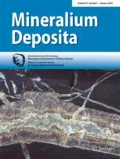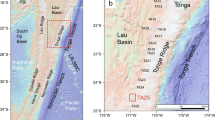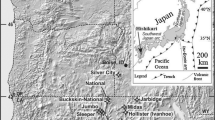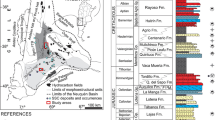Abstract
The presence of large amounts of atacamite in oxide zones from ore deposits in the Atacama Desert of northern Chile requires saline solutions for its formation and hyperarid climate conditions for its preservation. We investigated the nature and origin of atacamite-forming solutions by means of coupling groundwater geochemical analyses with fluid inclusion data, high-resolution mineralogical observations, and chlorine-36 (36Cl) data in atacamite from the Mantos Blancos and Spence Cu deposits. In both deposits, the salinities of fluid inclusions in atacamite are comparable to those measured in saline groundwaters sampled from drill holes. The average salinity of fluid inclusions in atacamite for the Mantos Blancos and Spence deposits (~7–9 and 2–3 wt.% NaCleq, respectively) are strongly correlated to the salinities at which gypsum supersaturates from groundwaters in both deposits (total dissolved solids ~5–9 and 1–3 wt.% NaCleq, respectively). This correlation is confirmed by transmission electron microscopy observations of atacamite-bearing samples, revealing an intimate association between atacamite and gypsum that can be traced down to the nanometer scale. 36Cl data in atacamite provide new lines of evidence concerning the origin and age of the saline waters that formed atacamite in various stratabound and porphyry Cu deposits from the Atacama Desert. All atacamite samples show very low 36Cl-to-Cl ratios (11 × 10−15 to 28 × 10−15 at at−1), comparable to previously reported 36Cl-to-Cl ratios of deep formation waters and old groundwaters. In addition, 36Cl-to-Cl ratios in atacamite correlate with U and Th concentration in the host rocks but are independent from distance to the ocean. This trend supports an interpretation of the low 36Cl-to-Cl ratios in atacamite as representing subsurface production of fissiogenic 36Cl in secular equilibrium with the solutions involved in atacamite formation. Therefore, 36Cl in atacamite strongly suggest that the chlorine in saline waters related to atacamite formation is old (>1.5 Ma) but that atacamite formation occurred more recently (<1.5 Ma) than suggested in previous interpretations. Our data provide new constraints on the origin of atacamite in Cu deposits from the Atacama Desert and support the recent notion that the formation of atacamite in hyperarid climates such as the Atacama Desert is an ongoing process that has occurred intermittently since the onset of hyperaridity.








Similar content being viewed by others
References
Alpers CN, Brimhall GH (1988) Middle Miocene climatic change in the Atacama Desert, northern Chile: evidence from supergene mineralization at La Escondida. Geol Soc Am Bull 100:1640–1656
Arancibia G, Matthews SJ, De Arce CP (2006) K-Ar and Ar-40/Ar-39 geochronology of supergene processes in the Atacama Desert, Northern Chile: tectonic and climatic relations. J Geol Soc London 163:107–118
Arcuri T, Brimhall G (2003) The chloride source for atacamite mineralization at the Radomiro Tomic porphyry copper deposit, Northern Chile. Econ Geol 98:1667–1681
Bentley HW, Phillips FM, Davis SN (1986) Chlorine-36 in the terrestrial environment. In: Fritz P, Fontes JC (eds) Handbook of environmental isotopes, vol. 2(B). The terrestrial environment. Elsevier, Amsterdam, pp 420–480
Bodnar RJ (1993) Revised equation and table for determining the freezing-point depression of H2O–NaCl solutions. Geochim Cosmochim Acta 57:683–684
Bodnar RJ, Bethke PM (1984) Systematics of stretching of fluid inclusions I: fluorite and sphalerite at an atmosphere confining pressure. Econ Geol 79:141–161
Bouzari F, Clark AH (2002) Anatomy, evolution, and metallogenic significance of the supergene orebody of the Cerro Colorado porphyry copper deposit, I region, northern Chile. Econ Geol 97:1701–1740
Cameron EM, Leybourne MI (2005) Relationship between groundwater chemistry and soil geochemical anomalies at the Spence copper porphyry deposit, Chile. Geochem Explor Environm Analysis A 5:135–145
Cameron EM, Leybourne MI, Kelley DL (2002) Exploring for deeply covered mineral deposits: formation of geochemical anomalies in northern Chile by earthquake-induced surface flooding of mineralized groundwaters. Geology 30:1007–1010
Cameron EM, Leybourne MI, Palacios C (2007) Atacamite in the oxide zone of copper deposits in northern Chile: involvement of deep formation waters? Miner Deposita 42:205–218
Chávez WX (2000) Supergene oxidation of copper deposits: zoning and distribution of copper oxide minerals. Soc Econ Geol News 41:1–21
Cuadra P, Rojas G (2001) Oxide mineralization at the Radomiro Tomic porphyry copper deposit, northern Chile. Econ Geol 96:387–400
Dietrich A (1999) Metallogenie, Geochemie und Schmelzeinschluss-Untersuchungen von tin porphyry und copper porphyry-Lagerstatten der zentralen Anden (Bolivien, Chile). Ph.D. Thesis, Clausthal University, Germany, 198 pp
Dunai TJ, González-Lopez GA, Juez-Larre J (2005) Oligocene–Miocene age of aridity in the Atacama Desert revealed by exposure dating of erosion-sensitive landforms. Geology 33:321–324
Fehn U, Snyder GT (2005) Residence times and source ages of deep crustal fluids: interpretation of l-129 and Cl-36 results from the KTB-VB drill site, Germany. Geofluids 5:42–51
Fehn U, Rich B, Tullai S, Kubik PW, Elmore D, Teng R (1988) Determination of Cl-36 and I-129 in waters from Cherry Hill, CA, a gold-bearing geothermal system. Chem Geol 70:135–135
Fehn U, Peters EK, Tullai-Fitzpatrick S, Kubik PW, Sharma P, Teng RTD, Gove HE, Elmore D (1992) I-129 and Cl-36 concentrations in waters of the Eastern Clear Lake Area, California: residence times and source ages of hydrothermal fluids. Geochim Cosmochim Acta 56:2069–2079
Glynn S, Mills RA, Palmer MR, Pancost RD, Severmann S, Boyce AJ (2006) The role of prokaryotes in supergene alteration of submarine hydrothermal sulfides. Earth Planet Sci Lett 244:170–185
Guendouz A, Michelot JL (2006) Chlorine-36 dating of deep groundwater from northern Sahara. J Hydrol 328:572–580
Hannington M (1993) The formation of atacamite during weathering of sulfides on the modern seafloor. Can Mineral 31:945–956
Hartley AJ, Chong G (2002) Late Pliocene age for the Atacama Desert: implications for the desertification of western South America. Geology 30:43–46
Hartley AJ, Rice CM (2005) Controls on supergene enrichment of porphyry copper deposits in the Central Andes: a review and discussion. Miner Deposita 40:515–525
Lehmann BE, Love A, Purtschert R, Collon P, Loosli HH, Kutschera W, Beyerle U, Aeschbach-Hertig W, Kipfer R, Frape SK, Herczeg A, Moran J, Tolstikhin IN, Groning M (2003) A comparison of groundwater dating with Kr-81, Cl-36 and He-4 in four wells of the Great Artesian Basin, Australia. Earth Planet Sc Lett 211:237–250
Leybourne MI, Cameron EM (2006) Composition of groundwaters associated with porphyry-Cu deposits, Atacama Desert, Chile: elemental and isotopic constraints on water sources and water–rock reactions. Geochim Cosmochim Acta 70:1616–1635
Leybourne MI, Cameron EM (2008) Source, transport, and fate of rhenium, selenium, molybdenum, arsenic, and copper in groundwater associated with porphyry-Cu deposits, Atacama Desert, Chile. Chem Geol 247:208–228
Lippmann J, Stute M, Torgersen T, Moser DP, Hall JA, Lin L, Borcsik M, Bellamy RES, Onstott TC (2003) Dating ultra-deep mine waters with noble gases and Cl-36, Witwatersrand Basin, South Africa. Geochim Cosmochim Acta 67:4597–4619
Luo SD, Ku TL (1991) U-series isochron dating: a generalized method employing total sample dissolution. Geochim Cosmochim Acta 55:555–564
Maksaev V, Munizaga F, Fanning M, Palacios C, Tapia J (2006) SHRIMP U-Pb dating of the Antucoya porphyry copper deposit: new evidence for an Early Cretaceous porphyry-related metallogenic epoch in the Coastal Cordillera of northern Chile. Miner Deposita 41:637–644
Maksaev V, Townley B, Palacios C, Camus F (2007) Metallic ore deposits. In: Moreno T, Gibbons W (eds) The geology of Chile. The Geological Society, London, pp 179–199
Metcalfe R, Crawford MB, Bath AH, Littleboy AK, Degnan PJ, Richards HG (2007) Characteristics of deep groundwater flow in a basin marginal setting at Sellafield, Northwest England: Cl-36 and halide evidence. Appl Geochem 22:128–151
Mote TI, Brimhall GH, Tidy-Finch E, Muller G, Carrasco P (2001) Application of mass-balance modeling of sources, pathways, and sinks of supergene enrichment to exploration and discovery of the Quebrada Turquesa exotic copper orebody, El Salvador district, Chile. Econ Geol 96:367–386
Oliveros V (2005) Etude géochronologique des unités magmatiques Jurassiques et Crétacé inférieur du nord du Chili (18°30′ - 24°S, 60°30 - 70°30′W): origine, mise en Place, altération, métamorphisme et minéralisations associées. Ph.D. Thesis, Université de Nice-Antipolis, France, 285 pp
Palacios C, Guerra N, Townley B, Lahsen A, Parada M (2005) Copper geochemistry in salt from evaporite soils, coastal range of the Atacama Desert, northern Chile: an exploration tool for blind Cu deposits. Geochem Explor Environm Analysis A 5:371–378
Palacios C, Ramirez LE, Townley B, Solari M, Guerra N (2007) The role of the Antofagasta–Calama Lineament in ore deposit deformation in the Andes of northern Chile. Miner Deposita 42:301–308
Phillips FM, Ayarbe JP, Harrison JBJ, Elmore D (2003) Dating rupture events on alluvial fault scarps using cosmogenic nuclides and scarp morphology. Earth Planet Sc Lett 215:203–218
Purdy CB, Helz GR, Mignerey AC, Kubik PW, Elmore D, Sharma P, Hemmick T (1996) Aquia aquifer dissolved Cl- and Cl-36/Cl: implications for flow velocities. Water Resour Res 32:1163–1171
Ramirez LE, Palacios C, Townley B, Parada MA, Sial AN, Fernandez-Turiel JL, Gimeno D, Garcia-Valles M, Lehmann B (2006) The Mantos Blancos copper deposit: An Upper Jurassic breccia-style hydrothermal system in the coastal range of northern Chile. Miner Deposita 41:246–258
Ramírez LE, Parada MA, Palacios C, Wittenbrink J (2008) Magmatic evolution of the Mantos Blancos copper deposit, Coastal Range of northern Chile: insight from Sr-Nd isotope, geochemical data and silicate melt inclusions. Resour Geol 58:124–142
Rao U, Fehn U, Teng RTD, Goff F (1996) Sources of chloride in hydrothermal fluids from the Valles caldera, New Mexico: a Cl-36 study. J Volcanol Geoth Res 72:59–70
Rech JA, Currie BS, Michalski G, Cowan AM (2006) Neogene climate change and uplift in the Atacama Desert, Chile. Geology 34:761–764
Reich M, Kesler SE, Utsunomiya S, Palenik CS, Chryssoulis SL, Ewing RC (2005) Solubility of gold in arsenian pyrite. Geochim Cosmochim Acta 69:2781–2796
Rowland MD, Clark AH (2001) Temporal overlap of supergene alteration and high-sulphidation mineralization in the Spence porphyry copper deposit, II Region, Chile. In: Geological Society of America Annual Meeting, Boston, Abstract 28064
Sharma P, Bourgeois M, Elmore D, Granger D, Lipschutz ME, Ma X, Miller T, Mueller K, Rickey F, Simms P, Vogt S (2000) PRIME lab AMS performance, upgrades and research applications. Nucl Instrum Meth B 172:112–123
Sillitoe RH (2005) Supergene oxidized and enriched porphyry copper and related deposits. In: Hedenquist JW, Thompson JFH, Goldfarb RJ, Richards JP (eds) Economic Geology 100th Anniversary Volume. Society of Economic Geologists, Littleton, pp 723–768
Sillitoe RH, McKee EH (1996) Age of supergene oxidation and enrichment in the Chilean porphyry copper province. Econ Geol 91:164–179
Snyder GT, Fabryka-Martin JT (2007) I-129 and Cl-36 in dilute hydrocarbon waters: marine-cosmogenic, in situ, and anthropogenic sources. Appl Geochem 22:692–714
Snyder GT, Riese WC, Franks S, Fehn U, Pelzmann WL, Gorody AW, Moran JE (2003) Origin and history of waters associated with coalbed methane: I-129, Cl-36, and stable isotope results from the Fruitland Formation, CO and NM. Geochim Cosmochim Acta 67:4529–4544
Suter M, Beer J, Bonani G, Hofmann HJ, Michel D, Oeschger H, Synal HA, Wölfli W (1987) Cl-36 studies at the ETH SIN-AMS Facility. Nucl Instrum Meth B 29:203–206
Trista-Aguilera D, Barra F, Ruiz J, Morata D, Talavera-Mendoza O, Kojima S, Ferraris F (2006) Re-Os isotope systematics for the Lince-Estefania deposit: constraints on the timing and source of copper mineralization in a stratabound copper deposit, Coastal Cordillera of Northern Chile. Miner Deposita 41:99–105
Ulrich MR, Bodnar RJ (1988) Systematics of stretching of fluid inclusions.2. Barite at 1-atm confining pressure. Econ Geol 83:1037–1046
Vanko DA, Bach W (2005) Heating and freezing experiments on aqueous fluid inclusions in anhydrite: recognition and effects of stretching and the low-temperature formation of gypsum. Chem Geol 223:35–45
Williams DB, Carter CB (1996) Transmission electron microscopy, 1–4. Plenum Press, New York
Acknowledgements
Support for this study was received from Comisión Nacional de Ciencia y Tecnología de Chile grant # 1070736 to Carlos Palacios, Martin Reich, and Miguel Angel Parada. We are grateful to BHP-Billiton for logistical assistance and for providing access to the Spence deposit and specifically to Martin J. Williams, Mario Sáez, Walter Ruf, and Jorge Peña for their help during open-pit and core sampling. We also thank Anglo American for providing us with samples from Mantos Blancos and for releasing analytical data for publication (research contract D-1012). The transmission electron microscope used in this work was acquired under the Mecesup grant UCH-0205. We thank Christian Nievas and Marcela Robles for TEM sample preparation. Z. Lu at the University of Rochester prepared the AgCl targets; M. Caffee and the AMS group at PrimeLab, Purdue University, carried out the 36Cl determinations; we appreciate their efforts. We acknowledge Bernd Lehmann for his helpful and constructive review of the manuscript.
Author information
Authors and Affiliations
Corresponding author
Additional information
Editorial handling: B. Lehmann
Rights and permissions
About this article
Cite this article
Reich, M., Palacios, C., Parada, M.A. et al. Atacamite formation by deep saline waters in copper deposits from the Atacama Desert, Chile: evidence from fluid inclusions, groundwater geochemistry, TEM, and 36Cl data. Miner Deposita 43, 663–675 (2008). https://doi.org/10.1007/s00126-008-0184-4
Received:
Accepted:
Published:
Issue Date:
DOI: https://doi.org/10.1007/s00126-008-0184-4




